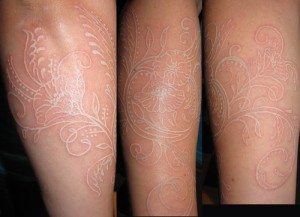Home » Blog » What You Need To Know About White Ink Tattoos
-
White Ink Tattoos
Tattoo trends have come and gone over the years, especially as tattoos have grown in popularity over the past couple decades. And among those many trends—UV ink tattoos, infinity symbol tattoos, watercolor style tattoos, trash polka, and more—comes a somewhat more recent development, which has taken the tattoo industry by storm as recently as just within the past couple years: white ink tattoos.
Many tattoo styles have eliminated the use of black ink for outlining in order to make the design appear softer, more feminine, or more subtle, but white ink tattoos take this concept a step further and create a final tattoo that is nearly imperceptible on the skin unless the viewer is up close, almost like an optical illusion. These tattoos can be elaborate and elegant or simplistic and edgy, and because of their subtlety on the skin, they are a popular option for those who want a tattoo, but who are worried about having something that draws too much attention or is too bold.
Are you considering getting a white ink tattoo? While this type of body modification is a newer trend, more is being discovered about them, and as alluring as they may be, white ink tattoos are not without their downsides. Read on to find out more about the white ink tattoo trend!
White Ink Heals Differently
The actual use of white ink in a tattoo is not a new phenom; in fact, it’s been used as a highlight color and even a mixing pigment in both color and black and grey tattoos. However, its effectiveness as a highlight color is often more successful than as the main (or in this case, only) pigment in a tattoo because when it’s put against another color or shade, the contrast makes the white appear even whiter, especially on lighter shades of skin. During the tattoo procedure, white ink often looks “bloodier” than black or even other colors of ink because its different consistency and color make the trauma to the skin more easily seen.
When this happens, it can be difficult to see how saturated the skin is with the ink, which tempts many tattoo artists to go over the design again to put more pigment into the skin. Sometimes with white ink, this is also necessary because the consistency of white ink is different, and sometimes it requires more vigorous application. The result? White ink tattoos can become raised due to the additional trauma once they heal.
It’s also important to note that when a white ink tattoo heals, the ink will, like all other tattoos, be resting underneath the topmost layer of skin. This makes the tattoo more natural-looking and, unfortunately, less vibrant. While your white ink tattoo will most assuredly look incredibly awesome after it’s first applied, keep in mind that it will fade slightly. On most tattoos this isn’t a huge problem, but since white ink is already pretty subtle, it might turn out a bit fainter than you’re imagining! Be mindful of this and have realistic expectations as your new tattoo heals.

How Does White Ink Interact With the Sun?
It’s no secret that sun is a tattoo’s worst enemy. The UV rays in sunlight are capable of penetrating the top layers of skin and affecting the ones that contain tattoo ink, which breaks the ink down and causes it to fade. Lighter colors are often more susceptible to fading, which means that white ink tattoos often fade faster and more noticeably than tattoos with black or other colors. However, white ink has another attribute as well.
When skin is exposed to the sun, the UV rays cause a higher production of melanin to protect it from damage, which is how freckles and tanned skin occur, and when white ink is exposed to UV rays, especially while the tattoo is healing, it can distort the color of this very light-colored pigment. Many people report that their white ink (myself included!) turns a yellow or brownish color over time as your skin adjusts to the exposure of UV rays. If you want a tattoo that exclusively uses white ink, you’ll have to remember to put sunscreen on it without fail when you go out into the sun, or keep the tattoo covered in sunlight, in order to keep it looking as bright as possible!
Find the Right Artist for the Job
Because white ink tattoos are more prone to fading, tattoo artists anticipate frequent touch-ups on this kind of art, and for this reason, many tattoo artists actually refuse to do white ink tattoos. A tattoo artist’s work is a reflection of their ability, and if the white ink tattoo doesn’t heal as well as it could because of its ink composition, it can reflect poorly on the reputation of the artist.
On the other side of the spectrum, some artists will specialize in this type of work because they have a lot of experience with it, and they’ll be more apt to be able to pack in the ink properly without scarring the tattoo and causing it to be raised. If a tattoo artist doesn’t have white ink tattoos in their portfolios, make sure to ask if it’s something that they can do, and also be sure to inquire if there is an extra charge for future touch-ups.
If you’re looking for a white ink tattoo, it can certainly be a striking, yet subtle addition to your living canvas—just be sure to keep these tips in mind and do your research in order to make your body art as beautiful as it can be for years to come!









